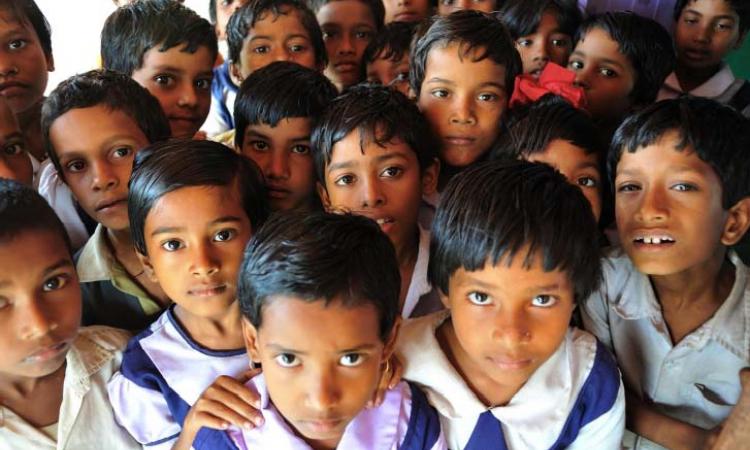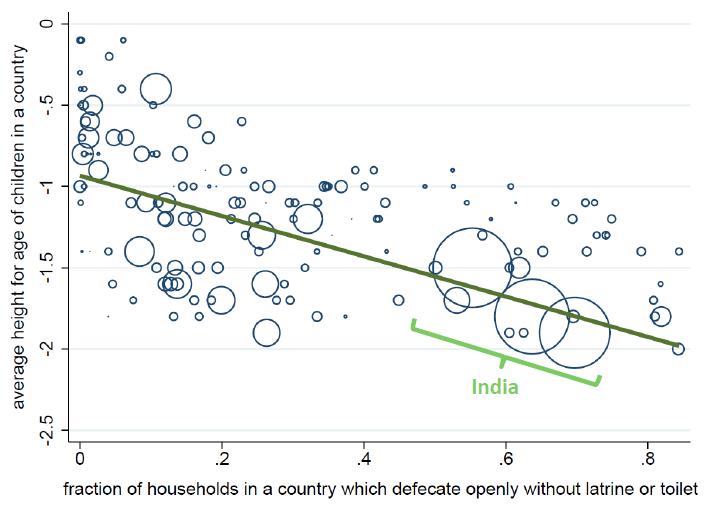
Children in India are shorter when compared to those in sub-Saharan Africa even though Indians have higher income levels. This paradox cannot be explained by genetic differences between the two. Government estimates show that 48% of children in India below the age of five are stunted, or have low height for their age (1).
New research by Dean Spears at Princeton University indicates that sanitation, more than income levels, determines the height of children. 54% of international differences in child height can be attributed to open defecation while a mere 29% can be attributed to Gross Domestic Product (GDP), as per Spears.
The persistence of food security and malnutrition problems despite economic growth has been labeled as the “Asian enigma" (2). First coined in the mid-nineties, this denotes the marginal relation nutritional status has with economic growth in the Asian region. As per an UN report “at the household level, adequate income also does not guarantee adequate nutrition; even among the richest quintile in India, 64 per cent of pre-school children are iron deficient and 26 per cent are underweight.” (2)
According to the UN, 165 million children worldwide are affected by this, leading to negative long-term impacts on physical and mental development that reduces productivity in adulthood.
Causal effect of sanitation on stunting
The sanitation theory Spears propounds looks at the causal relationship between the height of children and open defecation rates. Spears has used three sets of empirical data from both the regions (India and sub-Saharan Africa), all of which lead to the same conclusion that open defecation and child’s height are related.

Each circle in the chart represents a Demographic and Health Survey round, reflecting one country per year. The circle size is proportional to population. The three largest circles represent surveys at different times in India. The linear trend shows that there is a positive correlation between open defecation and child stunting.
The paper is a noteworthy one though it looks only at a child’s height, which is just one indicator of their well-being. Spears notes that the difference in height “is not accounted for by GDP or differences in food availability, governance, female literacy, breastfeeding, immunization, or other forms of infrastructure such as availability of water or electrification. Because changes over time within countries have an effect on height similar to the effect of differences across countries, it is safe to conclude that the effect is not a coincidental reflection of fixed genetic or cultural differences.” (3)
Poor sanitation hampers a child's growth as diseases like diarrhea, which are transmitted by faeces, lead to poor nutrient absorption by the gut and lowered appetite. This is reflected in their shorter heights. As per epidemiological studies, (Cochrane review, Chekley et al and Humphrey), the odds of stunting increase with the rise in diseases associated with fecal pathogens. An international comparative study indicates a positive correlation between open defecation and low haemoglobin levels, a factor which leads to anemia.
Does sanitation get its due?
More than access to drinking water, sanitation is a superior indicator of human well-being “due to the complex nature of social, institutional and cultural factors that play a role” (4). Yet, sanitation does not get its due. Open defecation, though bad for public health, continues unabated. In November 2012, the United Nations suggested that mobile phones were far more accessible to people than toilets. While more than a billion people defecate in the open, estimates indicate that “each day nearly 5,000 children worldwide die from diarrhea-related diseases, a toll that would drop dramatically if sufficient water for sanitation was available” (5).
As per a recent report in the Indian Express (6), 70% of rural households in India defecate in the open. 66% of households in India are forced to do so due to unavailability of toilets.
 These figures for open defecation are enormous considering the government's drive to eradicate open defecation by 2017 as a part of the Nirmal Bharat Abhiyaan (Total Sanitation Campaign). This community-led sanitation programme the Government of India has been running since the late nineties. The report bases itself on an evaluation study on Nirmal Bharat Abhiyaan done by the Planning Commission in May 2013. The Central and Eastern Indian States of Chhattisgarh, Madhya Pradesh, Bihar, Jharkhand and Orissa fare poorly with not even 30% having access to any source of sanitation. (7)
These figures for open defecation are enormous considering the government's drive to eradicate open defecation by 2017 as a part of the Nirmal Bharat Abhiyaan (Total Sanitation Campaign). This community-led sanitation programme the Government of India has been running since the late nineties. The report bases itself on an evaluation study on Nirmal Bharat Abhiyaan done by the Planning Commission in May 2013. The Central and Eastern Indian States of Chhattisgarh, Madhya Pradesh, Bihar, Jharkhand and Orissa fare poorly with not even 30% having access to any source of sanitation. (7)
At this rate, the country is expected to miss the 2015 Millennium Development Goal (MDG) target on improved sanitation access. As per the MDG goal, the per cent households without access to improved sanitation should be halved by 2015. School sanitation too is in a dismal shape in states such as Manipur, Assam, Bihar, Meghalaya, Madhya Pradesh and Jharkhand where even government schools are devoid of sanitary facilities.

“Analysis of the sanitation data by income quintiles reveals that the poorest 40 per cent in India have hardly benefitted from improvements in sanitation. The poorest quintile is 47 times more likely than their richest counterpart to practice open defecation, a disparity 3 times more severe than that observed in Africa.”(4)
The key role of open defecation in explaining child stunting in India was discussed at a conference at the Delhi School of Economics recently. While sanitation alone cannot explain stunting, Robert Chambers of the Institute for Development Studies, Sussex said that “hygiene was a blind spot for many concerned with child under nutrition”. Improvement in sanitation access likely played a big role in increasing average child height, as per Sangita Vyas, a researcher based on her work in Cambodia. The change in sanitation accounts for almost the entire change in height, she said.
A report by the London School of Hygiene and Tropical Medicine and WaterAid suggests small but noteworthy progress in the growth of children below five who have access to clean water and soap. Some fourteen studies conducted in low- and middle-income countries mostly across South Asia and sub-Saharan Africa show an average 0.5 cm height growth in children under the age of five through improved hygienic practices like the use of better quality water and soap.
Oliver Cumming, Environmental Health Group, London School of Hygiene and Tropical Medicine, while linking toilets and sanitation, said that there is suggestive evidence that Water, Sanitation and Hygiene (WASH) was effective in reducing stunting. There is a need to rethink the design and targeting of some WASH programmes. Manisha Shah of UCLA said that sanitation components should be strengthened through subsidized pricing, credit and community financing.
The answer lies in building toilets and as Oliver Cumming suggests “people need to own the toilets they use”. At the same time there is a need now to move away from conventional toilet construction oriented approach while implementing sanitation programmes. Demand driven community-led approaches where people are encouraged to use toilets need to be promoted. This way the sanitation infrastructure is less likely to fall into disrepair and disuse.
References
(1) http://mospi.nic.in/mospi_new/upload/Children_in_India_2012.pdf)
(3) https://www.thehindu.com/opinion/lead/the-long-and-short-of-open-defecation/article4505664.ece
(4) Sridhar Vedachalam, Water supply and sanitation in India: Meeting targets and beyond (pdf), Cornell University)
(5) Vedachalam, S. (2011), ‘WaSH and Human Development’, Aguanomics, blog post dated May 18, available at: http://www.aguanomics.com/2011/05/wash-and-human-development.html.
(6) http://www.indianexpress.com/news/73-pc-rural-households-defecate-in-open/1133854/)
(7) International Institute for Population Sciences and Macro International. (2007), ‘National Family Health Survey (NFHS-3), 2005-06: India: Volume I’, Mumbai: IIPS.